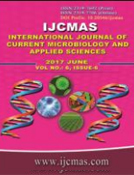


 National Academy of Agricultural Sciences (NAAS)
National Academy of Agricultural Sciences (NAAS)

|
PRINT ISSN : 2319-7692
Online ISSN : 2319-7706 Issues : 12 per year Publisher : Excellent Publishers Email : editorijcmas@gmail.com / submit@ijcmas.com Editor-in-chief: Dr.M.Prakash Index Copernicus ICV 2018: 95.39 NAAS RATING 2020: 5.38 |
A pot culture experiment was conducted in the green house of the Department of Soil Science and Agricultural Chemistry, College of Agriculture, IGKV, Raipur during kharif season 2015 to study the crop response based assessment of limiting nutrients using site specific nutrient management for yield maximization in Vertisols of Bemetara district of Chhattisgarh. The treatments constituted with application of all nutrients applied at optimum level known as SSNM dose while in others, one of the nutrient elements from all the nutrient treatments was omitted. Total 11 treatments were tested with rice (MTU-1010) as a test crop, laid out in CRD with three replications. Grain and straw yields of rice was significantly reduced with the omission of N, P, and S in comparison to the treatment receiving all the nutrients (SSNM). The yield reductions were more pronounced with N and P omission as 54.76 and 44.73 %, respectively. The per cent reduction in rice yields recorded as 11.63 % with S omission, 8.99 % with Zn omission and 6.51% with B omission treatments. Based on the performance of rice crop during Kharif season, the yield limiting nutrients identified were in the order of N > P > S > Zn > B. These limiting nutrients were tested on farmer's fields with wheat crop during Rabi season, 2015-16 where bulk soil samples were collected for pot culture study. The limiting nutrients applied in optimum doses (SSNM) as N - 150, P2O5 - 100, K2O - 80, S - 45, B -3 and Zn – 7.5 kg/ha. The wheat yield was recorded 29% higher as compared to the farmer’s fertilizer practice (80:58:38 kg N: P2O5: K2O).
 |
 |
 |
 |
 |